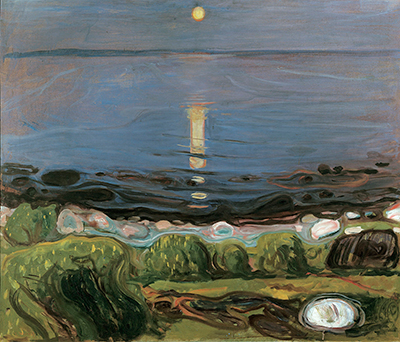Summer Night by the Beach is an oil on canvas painting depicting the reflection of the moonlight on the surface of the water. This is way far than a presentation of natural impression and the pale glow is staged as a column of light that pinpoints the observer's location in the cosmos similar to an exclamation point.
True to his words and paintings he depicted nature as the inner pictures of the soul rather than what is visible. Created in between 1902-1903 in Berlin, Germany and it was during his stay in Berlin that he sketched out most of the ideas that would later comprise his major artwork The Frieze of Life. Today Summer Night by the Beach is housed in the Munch Museum of Art in Oslo together with the other artworks that he created during his golden years. Drawing his influence from Impressionists such as Edouard Manet. This further explains Summer Night by the Beach painting which is a natural impression that best describes nature with fine brushstrokes and hidden emotions.
Also, the post-impressionism style influenced Munch's artworks that he based his artwork around this style and among other artists that influenced him were Vincent van Gogh and Paul Gauguin. Munch's artwork inspired the growth of Fauvism and he showcased his works in their exhibition. The Frieze of Life encompassed 22 works with artworks bearing such titles as Anxiety, Jealousy, Despair, Melancholy and The Scream. The last painting would go to become one of the most famous paintings in art history. The collection was successful and it made Munch to be known to the art world. Gustav Klimt was so influenced by Munch’s work that he did a painting of The Kiss which resembled Kiss by the Window by Edvard Munch.
Edvard Munch often used rings of colors and shadows to emphasize a great feeling of menace, anxiety, sexual intensity or fear. These paintings represented his pessimism regarding the existence of humans and his turbulent love life. His unique style had a symphonic effect that is it created a great stir with a lot of antagonism and approval. The public criticized his work for being alien and strange while some art critics had begun to understand and appreciate his work. From this painting, we learn to appreciate nature and it will reward us with beautiful memories that we can put into artwork and use them for future generations.




